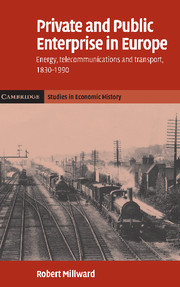Book contents
- Frontmatter
- Contents
- List of figures
- List of tables
- Preface
- Glossary and abbreviations
- Map: The European economy in 1914
- Part I Introduction
- Part II The Construction of the New European Infrastructure c. 1830–1914
- Part III Nations and Networks c. 1914–1945
- Part IV State Enterprise c. 1945–1990
- 10 The new state, economic organisation and planning
- 11 Coal, oil and security
- 12 Airline regulation and the transport revolution
- 13 Telecommunications 1950–1990: from calm to storm
- 14 Economic policy, financial accountability and productivity growth
- Part V Conclusions
- Appendix: Infrastructure service levels and public ownership c. 1910: a statistical analysis
- Bibliography
- Index
11 - Coal, oil and security
Published online by Cambridge University Press: 14 July 2009
- Frontmatter
- Contents
- List of figures
- List of tables
- Preface
- Glossary and abbreviations
- Map: The European economy in 1914
- Part I Introduction
- Part II The Construction of the New European Infrastructure c. 1830–1914
- Part III Nations and Networks c. 1914–1945
- Part IV State Enterprise c. 1945–1990
- 10 The new state, economic organisation and planning
- 11 Coal, oil and security
- 12 Airline regulation and the transport revolution
- 13 Telecommunications 1950–1990: from calm to storm
- 14 Economic policy, financial accountability and productivity growth
- Part V Conclusions
- Appendix: Infrastructure service levels and public ownership c. 1910: a statistical analysis
- Bibliography
- Index
Summary
In the third quarter of the twentieth century, oil replaced coal as the major source of energy in western Europe. During the last quarter, the growing power of the nations with oil reserves and the price increases introduced from the early 1970s by their cartel, the Organisation of Petroleum Exporting Countries (OPEC), ensured that oil lost its predominance and mixed regimes of nuclear, HEP, oil, natural gas and coal emerged. Before the Second World War, coal was dominant, and the concentration of deposits in the UK, the Low Countries and Germany had vital effects on the energy policies of other European countries. I said little in earlier chapters about the structure of the coal industry and how it was regulated. As a natural resource, coal has certain similarities to oil, and in this chapter I attempt to explain how and why coal and oil were owned and regulated, to draw out the implications for the generation of electricity supply and to identify the key interests of the state.
The economic organisation of the coal and oil sectors was very different from the other infrastructure industries. In brief, private enterprise has been dominant in much of the period since 1850, albeit with governments not far away. The need to control monopoly elements by price regulation and profit constraints was not strong.
- Type
- Chapter
- Information
- Private and Public Enterprise in EuropeEnergy, Telecommunications and Transport, 1830–1990, pp. 208 - 230Publisher: Cambridge University PressPrint publication year: 2005

